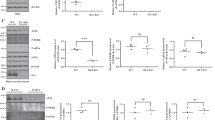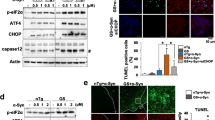Abstract
Endoplasmic reticulum (ER) stress has been shown to be associated with the pathogenesis of neurodegenerative disorders including Parkinson’s disease (PD). HtrA2/Omi, from its participation in protein quality control, is involved in ER stress. However, little is known about the relationship between HtrA2/Omi and ER stress in PD. Here, we explored the association of HtrA2/Omi and ER stress in a cell model of PD and found that the expression level of HtrA2/Omi decreased with ER stress induction in 6-OHDA-treated SH-SY5Y cells. Furthermore, silencing endogenous expression of HtrA2/Omi with siRNA resulted in aggregated ER stress and cell death. Taken together, our results show that HtrA2/Omi may exert a protective function in 6-OHDA-induced cell death by regulating ER stress-related proteins. This research offers some clues as why mutations in HtrA2/Omi lead to higher susceptibility in some PD patients.








Similar content being viewed by others
References
Anelli T, Sitia R (2008) Protein quality control in the early secretory pathway. EMBO J 27(2):315–327
Gray CW, Ward RV et al (2000) Characterization of human HtrA2, a novel serine protease involved in the mammalian cellular stress response. Eur J Biochem 267(18):5699–5710
Greenamyre JT, Hastings TG (2004) Biomedicine. Parkinson’s—divergent causes, convergent mechanisms. Science 304(5674):1120–1122
Han C, Nam MK et al (2008) Tunicamycin-induced ER stress upregulates the expression of mitochondrial HtrA2 and promotes apoptosis through the cytosolic release of HtrA2. J Microbiol Biotechnol 18(6):1197–1202
Hegde R, Srinivasula SM et al (2002) Identification of Omi/HtrA2 as a mitochondrial apoptotic serine protease that disrupts inhibitor of apoptosis protein–caspase interaction. J Biol Chem 277(1):432–438
Hoozemans JJ, van Haastert ES et al (2007) Activation of the unfolded protein response in Parkinson’s disease. Biochem Biophys Res Commun 354(3):707–711
Huttunen HJ, Guenette SY et al (2007) HtrA2 regulates beta-amyloid precursor protein (APP) metabolism through endoplasmic reticulum-associated degradation. J Biol Chem 282(38):28285–28295
Imai Y, Soda M et al (2001) An unfolded putative transmembrane polypeptide, which can lead to endoplasmic reticulum stress, is a substrate of Parkin. Cell 105(7):891–902
Inagaki R, Tagawa K et al (2008) Omi/HtrA2 is relevant to the selective vulnerability of striatal neurons in Huntington’s disease. Eur J Neurosci 28(1):30–40
Jiang P, Gan M et al (2010) ER stress response plays an important role in aggregation of alpha-synuclein. Mol Neurodegener 5:56
Jones JM, Albin RL et al (1993) mnd2: a new mouse model of inherited motor neuron disease. Genomics 16(3):669–677
Jones JM, Datta P et al (2003) Loss of Omi mitochondrial protease activity causes the neuromuscular disorder of mnd2 mutant mice. Nature 425(6959):721–727
Kahle PJ, Haass C (2004) How does parkin ligate ubiquitin to Parkinson’s disease? EMBO Rep 5(7):681–685
Katayama T, Imaizumi K et al (2001) Disturbed activation of endoplasmic reticulum stress transducers by familial Alzheimer’s disease-linked presenilin-1 mutations. J Biol Chem 276(46):43446–43454
Lee do Y, Lee KS et al (2010) Activation of PERK signaling attenuates Abeta-mediated ER stress. PLoS One 5(5):e10489
Liu MJ, Liu ML et al (2007) Transgenic mice with neuron-specific overexpression of HtrA2/Omi suggest a neuroprotective role for HtrA2/Omi. Biochem Biophys Res Commun 362(2):295–300
Ma Y, Hendershot LM (2004) ER chaperone functions during normal and stress conditions. J Chem Neuroanat 28(1–2):51–65
Makioka K, Yamazaki T et al (2010) Involvement of endoplasmic reticulum stress defined by activated unfolded protein response in multiple system atrophy. J Neurol Sci 297(1–2):60–65
Martins LM, Morrison A et al (2004) Neuroprotective role of the Reaper-related serine protease HtrA2/Omi revealed by targeted deletion in mice. Mol Cell Biol 24(22):9848–9862
Moisoi N, Klupsch K et al (2009) Mitochondrial dysfunction triggered by loss of HtrA2 results in the activation of a brain-specific transcriptional stress response. Cell Death Differ 16(3):449–464
Mosmann T (1983) Rapid colorimetric assay for cellular growth and survival: application to proliferation and cytotoxicity assays. J Immunol Methods 65(1–2):55–63
Oh YM, Jang EH et al (2009) Inhibition of 6-hydroxydopamine-induced endoplasmic reticulum stress by l-carnosine in SH-SY5Y cells. Neurosci Lett 459(1):7–10
Pizzo P, Pozzan T (2007) Mitochondria–endoplasmic reticulum choreography: structure and signaling dynamics. Trends Cell Biol 17(10):511–517
Puthalakath H, O’Reilly LA et al (2007) ER stress triggers apoptosis by activating BH3-only protein Bim. Cell 129(7):1337–1349
Ryu EJ, Harding HP et al (2002) Endoplasmic reticulum stress and the unfolded protein response in cellular models of Parkinson’s disease. J Neurosci 22(24):10690–10698
Sasaki S (2010) Endoplasmic reticulum stress in motor neurons of the spinal cord in sporadic amyotrophic lateral sclerosis. J Neuropathol Exp Neurol 69(4):346–355
Sato N, Urano F et al (2000) Upregulation of BiP and CHOP by the unfolded-protein response is independent of presenilin expression. Nat Cell Biol 2(12):863–870
Shen X, Zhang K et al (2004) The unfolded protein response—a stress signaling pathway of the endoplasmic reticulum. J Chem Neuroanat 28(1–2):79–92
Strauss KM, Martins LM et al (2005) Loss of function mutations in the gene encoding Omi/HtrA2 in Parkinson’s disease. Hum Mol Genet 14(15):2099–2111
Terro F, Czech C et al (2002) Neurons overexpressing mutant presenilin-1 are more sensitive to apoptosis induced by endoplasmic reticulum–Golgi stress. J Neurosci Res 69(4):530–539
Verhagen AM, Silke J et al (2002) HtrA2 promotes cell death through its serine protease activity and its ability to antagonize inhibitor of apoptosis proteins. J Biol Chem 277(1):445–454
Xu C, Bailly-Maitre B et al (2005) Endoplasmic reticulum stress: cell life and death decisions. J Clin Invest 115(10):2656–2664
Yoshida H (2007) ER stress and diseases. FEBS J 274(3):630–658
Zhang P (1999) The use of arsenic trioxide (As2O3) in the treatment of acute promyelocytic leukemia. J Biol Regul Homeost Agents 13(4):195–200
Zhang TC, Cao EH et al (1999) Induction of apoptosis and inhibition of human gastric cancer MGC-803 cell growth by arsenic trioxide. Eur J Cancer 35(8):1258–1263
Zinszner H, Kuroda M et al (1998) CHOP is implicated in programmed cell death in response to impaired function of the endoplasmic reticulum. Genes Dev 12(7):982–995
Acknowledgments
This work was supported by “863” project (2007AA02Z460), “973” project (2010AB973Z531) from the Ministry of Science and Technology of the People’s Republic of China, a grant from Nature Science Foundation of China (81071032), and a grant supported by key project (ZDXM080214) from Hainan provincial Science and Technology Department.
Author information
Authors and Affiliations
Corresponding authors
Additional information
Feifei Luo, Lei Wei, Congcong Sun, and Xiaowu Chen contributed equally to this work.
Rights and permissions
About this article
Cite this article
Luo, F., Wei, L., Sun, C. et al. HtrA2/Omi is Involved in 6-OHDA-Induced Endoplasmic Reticulum Stress in SH-SY5Y Cells. J Mol Neurosci 47, 120–127 (2012). https://doi.org/10.1007/s12031-011-9694-0
Received:
Accepted:
Published:
Issue Date:
DOI: https://doi.org/10.1007/s12031-011-9694-0




